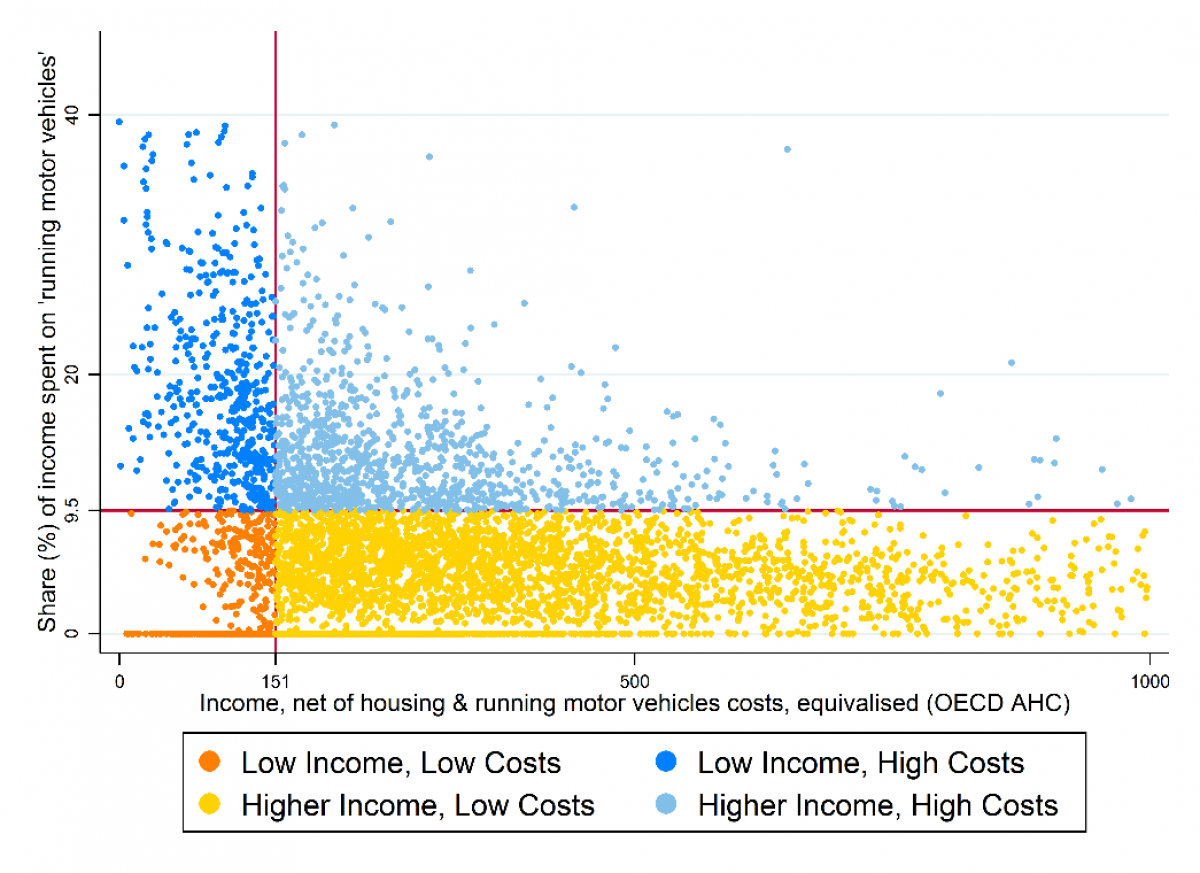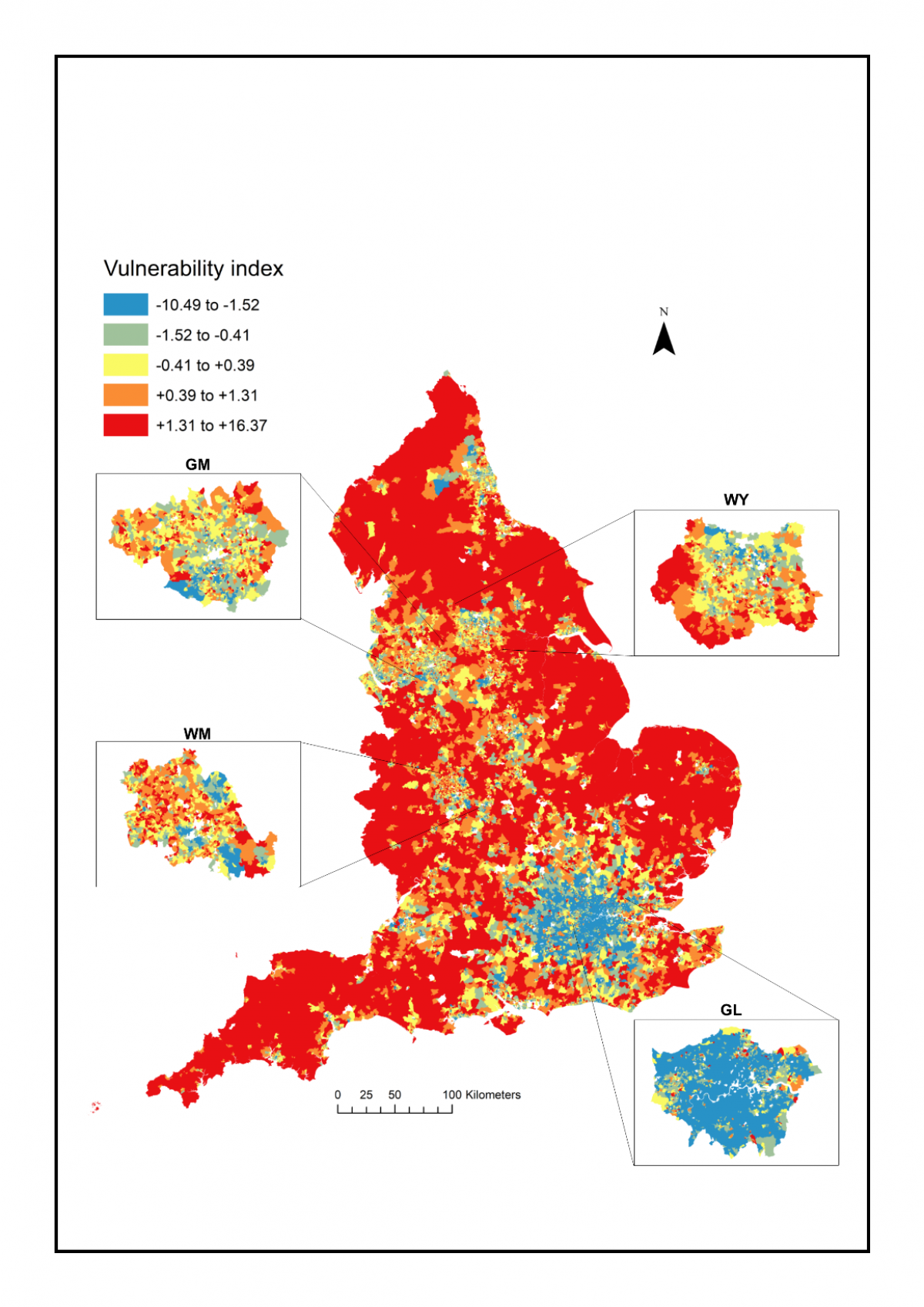Mattioli, G. (2021) Transport poverty in the UK, EP-pedia, ENGAGER COST Action.
Perspective on transport energy poverty in the UK policy debate
The notion of transport energy poverty is not common in the UK. While Britain pioneered the notion of ‘fuel poverty’ and related policy-making in the 1980s-1990s, official definitions of fuel poverty have remained narrowly focused on domestic energy needs, and policy and public discourse typically focus on space heating only.
In this context, various actors (researchers, NGOs, and occasionally policy-makers) have put forward the notion of ‘transport poverty’, building on an implicit analogy between (recognised) fuel poverty and (neglected) transport affordability issues. However, the substantial equivalence between the two issues is typically taken for granted, meaning that the justification for this analogy and implications for how transport affordability should be defined, measured and tackled are rarely discussed.
In 2013, the Environmental Audit Committee of the House of Commons' inquiry into “Transport and the accessibility to public services” asked stakeholders whether “a measure of the transport accessibility of key public services, in a similar manner as ‘fuel poverty’, (would) be useful for policy-making (and if so, how should it be defined?)”, finding “some support” for the idea (EAC, 2013, p. 9–10). Since 2012, the sustainable transport charity has published reports mapping the ‘risk of transport poverty’ in England, Scotland and Wales, based on a composite indicator considering car expenditure relative to income (adopting Brenda Boardman’s 10% threshold), and accessibility with transport modes alternative to the car. Results for England (Sustrans, 2012) suggest that “nearly 1.5 million people are at high risk of suffering from ‘transport poverty’. Half of all local authorities in England have at least one high risk area”. Sustrans recommends that the government tackle the problem by improving modal alternatives to the car and moving away from car-dependent transport planning.
While an explicit notion of transport energy poverty does not exist in the UK, issues concerning transport energy affordability are present in the policy debate. In 1993, the government introduced a ‘fuel duty escalator’, i.e. an environmentally motivated annual duty increased above the rate of inflation, which resulted in a significant increase in the real price of transport fuel in the 1990s. The measure was discontinued in 2000 following protests by truck owner-operators, which threatened to bring the country to a halt (Lyons & Chatterjee, 2002). In 2012, in a period of economic crisis and high oil prices, the UK government decided to ‘freeze’ the fuel duty, a decision that was confirmed in all subsequent annual budgets up to 2020, resulting in a reduction of the fuel duty in real terms over the period. The freeze in fuel duty has been criticized for resulting in traffic growth, worsening congestion and pollution, lost tax revenue, and reduced public transport use (Begg & Haig, 2018).
Thus, in the last 25 years UK governments have performed a policy U-turn, going from actively promoting higher fuel prices, to pursuing a reduction. Concerns around the impact of high fuel prices on the motoring poor contributed to this policy change. For example, in early 2012the Royal Automobile Club Foundation (RACF) published figures on transport expenditures suggesting that 80% of the British population (i.e. all income quintiles except the bottom one) were in ‘transport poverty’. This assessment was based on the direct transposition of Boardman’s ‘ten per cent’ indicator to transport expenditure, which for various reasons leads to misleading results (see Mattioli et al., 2017). Despite this, the figures were used by RACF to argue against fuel duty increases and were widely picked up by the media, possibly influencing the government’s decision to introduce a fuel duty freeze in 2012.
While quite separate from fuel price debates, the UK has a long tradition of policy interest for transport-related social exclusion, and has arguably pioneered policy-making in this area, starting with the 2003 report of the Social Exclusion Unit (2003) commissioned by the then Labour government. The concern here is much broader than just the affordability of transport energy, including notably the problems of carless households, and of all those social groups that for various reasons (e.g. disability, old age, etc.) experience difficulties in accessing essential services and opportunities. In this context, ‘accessibility planning’ was introduced in 2006 to ensure that there is a clear policy responsibility for improving accessibility within local areas, although the merits of this policy approach are debated (Curl et al., 2011).
In the UK, as for example in France and the US, financial aids to car ownership and use (e.g. low-interest loans to subsidize vehicle acquisition, subsidised driving lessons, repair and maintenance grants, and social benefits to cover the cost of car trips) have been implemented locally as part of welfare-to-work programmes. However, they have not been upscaled to the national level, for reasons related to cost to the public purse, the conflict with environmental policy goals and the risk of encouraging car ownership among households who are not able to afford the associated running costs (Fol et al., 2007).
Among the measures addressing the cost of transport in the UK are also ‘concessionary fares’ on public transport, which are offered to groups such as disabled and older people, and funded through general taxation. The English National Concessionary Bus Travel Scheme offers free bus travel to seniors, and was introduced specifically to address affordability problems among them. It has been criticised for being very expensive and poorly targeted to actual affordability problems, as older people are entitled to it regardless of income, while other disadvantaged categories (e.g. the unemployed) receive no help at all.
Research perspective on transport energy poverty in the UK
The UK has a strong tradition of ‘transport and social exclusion’ research (Lucas et al., 2012), emerging particularly in the early 2000s. This has made Britain an international reference for research in this area, similarly to what happened for domestic fuel and energy poverty. British transport and social exclusion research, however, has generally stopped short of framing these issues as a form of energy poverty, and has tended to run separately to fuel poverty research.
Despite an early contribution of Brenda Boardman on this topic in the 1990s (Boardman, 1998), it was not until much later that transport energy affordability was empirically investigated in any detail. Building on earlier ‘oil vulnerability’ research from Australia, Lovelace and Philips (2014) mapped vulnerability to transport fuel price increases in the Yorkshire region, partly based on a fuel-poverty-inspired indicator, showing that vulnerability is higher in car dependent rural areas around cities with less coping capacity.
The research project (t)ERES (2014-2016) focused on the transport equivalent of energy poverty, proposing three indicators to assess its incidence in the UK. Mattioli et al. (2018) have adapted Hills’ ‘Low-Income High-Cost’ indicator of fuel poverty for use in the transport sector, estimating that roughly 9% of UK households have high motoring costs (as a share of income) despite being on low incomes (based on 2012 household expenditure data) (Fig.1). These households also appear to have little adaptive capacity to fuel price increases, as their demand for motor fuel is relatively inelastic.

In a related study using EU-SILC data, Mattioli (2017) finds that in 2012 about 7% of UK households owned a car despite being in material deprivation, which may expose them to transport energy poverty. Interestingly, roughly 80% of these households were also in domestic energy poverty, suggesting that there may be an overlap between the two problems, i.e. what is sometimes referred to as ‘double energy vulnerability’. Mattioli et al. (2019) have mapped vulnerability to fuel price increases in England, based on spatial data on motor vehicle use, income and accessibility to services and opportunities by different travel modes (with reference to the year 2011). They define vulnerability as the combination of high expenditure on motor fuel, low income and poor access to essential services by modal alternatives to the car. The results show relatively high levels of vulnerability in rural and periurban areas, but also a big divide between London (low vulnerability as a result of high income and low car dependence) and other city-regions in the North of England (with higher vulnerability as a result of lower income and worse public transport provision) (Fig.2).

Finally, Robinson and Mattioli (2020) mapped ‘double energy vulnerability’ in England, i.e. the overlap of domestic energy poverty and ‘transport energy poverty’ (operationalised as vulnerability to fuel price increases), based on 2011/2012 data. The results show that as many as 6% of neighbourhoods (accounting for 3 million residents) have a high propensity towards double energy vulnerability, typically concentrating in isolated, rural neighbourhoods (Fig.3). The overlaps and interactions between domestic and transport energy poverty are the object of the ongoing research project FAIR (‘Fuel and transport poverty in the UK’s energy transition’ 2020-2023) (Martiskainen et al., 2020).

Begg, D., & Haigh, C. (2018). The unintended consequences of freezing fuel duty. Greener Journeys.
Boardman, B. (1998). Rural transport policy and equity. Discussion paper prepared for CPRE, the Countryside Commission and the Rural Development Commission.
Curl, A., Nelson, J. D., & Anable, J. (2011). Does accessibility planning address what matters? A review of current practice and practitioner perspectives. Research in Transportation Business & Management, 2, 3-11. https://doi.org/10.1016/j.rtbm.2011.07.001
EAC (2013). Transport and Accessibility to Public Services. Third report of session 2013-2014, vol. I, The Stationery Office, London.
Fol, S., Dupuy, G., & Coutard, O. (2007). Transport policy and the car divide in the UK, the US and France: beyond the environmental debate. International Journal of Urban and Regional Research, 31(4), 802-818. https://doi.org/10.1111/j.1468-2427.2007.00755.x
Lovelace, R., & Philips, I. (2014). The ‘oil vulnerability’ of commuter patterns: A case study from Yorkshire and the Humber, UK. Geoforum, 51, 169-182. https://doi.org/10.1016/j.geoforum.2013.11.005
Lucas, K. (2012). Transport and social exclusion: Where are we now?. Transport Policy, 20, 105-113. https://doi.org/10.1016/j.tranpol.2012.01.013
Lyons, G., & Chatterjee, K. (2002). Transport lessons from the fuel tax protests of 2000. Routledge.
Martiskainen, M., Sovacool, B. K., Lacey-Barnacle, M., Hopkins, D., Jenkins, K. E., Simcock, N., ... & Bouzarovski, S. (2020). New Dimensions of Vulnerability to Energy and Transport Poverty. Joule. https://doi.org/10.1016/j.joule.2020.11.016
Mattioli, G., Lucas, K., & Marsden, G. (2017). Transport poverty and fuel poverty in the UK: from analogy to comparison. Transport Policy, 59, 93-105. https://doi.org/10.1016/j.tranpol.2017.07.007
Mattioli, G., Wadud, Z., & Lucas, K. (2018). Vulnerability to fuel price increases in the UK: A household level analysis. Transportation Research Part A, 113, 227-242. https://doi.org/10.1016/j.tra.2018.04.002
Mattioli, G., Philips, I., Anable, J., & Chatterton, T. (2019). Vulnerability to motor fuel price increases: Socio-spatial patterns in England. Journal of Transport Geography, 78, 98-114. https://doi.org/10.1016/j.jtrangeo.2019.05.009
Robinson, C., & Mattioli, G. (2020). Double energy vulnerability: Spatial intersections of domestic and transport energy poverty in England, Energy Research & Social Science, 101699. https://doi.org/10.1016/j.erss.2020.101699
SEU (2003). Making the Connections: Final Report on Transport and Social Exclusion. Office of the Deputy Prime Minister, London.
Sustrans, (2012). Locked Out. Transport Poverty in England [Online] Available from: http://www.sustrans.org.uk/lockedout

